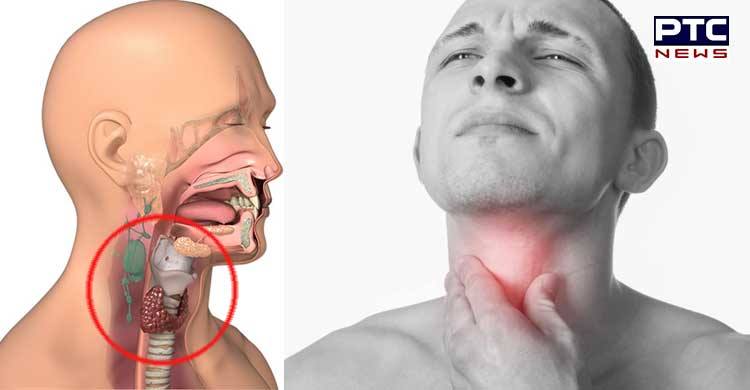
Laryngeal and Hypopharyngeal cancer- symptoms and treatment
:
Laryngeal and hypopharyngeal cancers start in the lower part of the throat. Cancers that start in the larynx are termed aslaryngeal cancers. Cancers that start in the hypopharynx are called hypopharyngeal cancers.
Majorly all the cancers in the larynx or hypopharynx develop from thin, flat cells called squamous cells, which are in the epithelium, the innermost layer lining these 2 structures. Cancer that starts in this layer of cells is called squamous cell carcinoma or squamous cell cancer.
 What is the larynx?
The larynx is the voice box. It’s one of the organs that help us speak. It contains vocal cords. It is located in the neck, above the opening of the trachea (windpipe). There, it helps keep food and fluids from entering the trachea.Cancer that starts in the larynx (laryngeal cancer) is treated based on which section it begins in.
What is the hypopharynx?
The hypopharynx is the part of the throat (pharynx) that lies beside and behind your larynx. The hypopharynx is the entrance into the esophagus (the tube that connects the throat to the stomach).
Risk Factors:
A risk factor can be anything that affects your chance of getting a disease like cancer. Different cancers have different risk factors associated with them.
What is the larynx?
The larynx is the voice box. It’s one of the organs that help us speak. It contains vocal cords. It is located in the neck, above the opening of the trachea (windpipe). There, it helps keep food and fluids from entering the trachea.Cancer that starts in the larynx (laryngeal cancer) is treated based on which section it begins in.
What is the hypopharynx?
The hypopharynx is the part of the throat (pharynx) that lies beside and behind your larynx. The hypopharynx is the entrance into the esophagus (the tube that connects the throat to the stomach).
Risk Factors:
A risk factor can be anything that affects your chance of getting a disease like cancer. Different cancers have different risk factors associated with them.
 Laryngeal and hypopharyngeal cancers are often grouped with other cancers of the mouth and throat (commonly called head and neck cancers). These cancers often have many of the same risk factors, which are listed below.
Tobacco and Alcohol consumption:
Tobacco use is the most important risk factor for head and neck cancers (including cancers of the larynx and hypopharynx). The risk for these cancers is much higher in smokers than in non-smokers.
Moderate or heavy alcohol use (more than 1 drink a day) also increases the risk of these cancers, although not as much as smoking.People who use both tobacco and alcohol come into the highest risk of all categories. Combining these two habits doesn’t just add both risks together, it actually multiplies them.
Poor nutrition:
Poor nutrition may increase the risk of getting head and neck cancer. The exact reason for this isn’t clear. Heavy drinkers often have vitamin deficiencies, which may help explain the role of alcohol in increasing risk of these cancers.
Human papillomavirus infection:
Human papillomavirus (HPV) is a group of over 150 related viruses. They are called papilloma viruses because some of them cause a type of growth called a papilloma, more commonly known as a wart.Infection with certain types of HPV can also cause some forms of cancer, including cancers of the penis, cervix, vulva, vagina, anus, and throat.
Genetic syndromes:
People with syndromes caused by inherited gene defects (mutations) have a very high risk of throat cancer, including cancer of the hypopharynx.
Workplace exposures:
Long and intense exposures to wood dust, paint fumes and certain chemicals used in the metal working, petroleum, plastics and textile industries can increase the risk of laryngeal and hypopharyngeal cancers.
Laryngeal and hypopharyngeal cancers are often grouped with other cancers of the mouth and throat (commonly called head and neck cancers). These cancers often have many of the same risk factors, which are listed below.
Tobacco and Alcohol consumption:
Tobacco use is the most important risk factor for head and neck cancers (including cancers of the larynx and hypopharynx). The risk for these cancers is much higher in smokers than in non-smokers.
Moderate or heavy alcohol use (more than 1 drink a day) also increases the risk of these cancers, although not as much as smoking.People who use both tobacco and alcohol come into the highest risk of all categories. Combining these two habits doesn’t just add both risks together, it actually multiplies them.
Poor nutrition:
Poor nutrition may increase the risk of getting head and neck cancer. The exact reason for this isn’t clear. Heavy drinkers often have vitamin deficiencies, which may help explain the role of alcohol in increasing risk of these cancers.
Human papillomavirus infection:
Human papillomavirus (HPV) is a group of over 150 related viruses. They are called papilloma viruses because some of them cause a type of growth called a papilloma, more commonly known as a wart.Infection with certain types of HPV can also cause some forms of cancer, including cancers of the penis, cervix, vulva, vagina, anus, and throat.
Genetic syndromes:
People with syndromes caused by inherited gene defects (mutations) have a very high risk of throat cancer, including cancer of the hypopharynx.
Workplace exposures:
Long and intense exposures to wood dust, paint fumes and certain chemicals used in the metal working, petroleum, plastics and textile industries can increase the risk of laryngeal and hypopharyngeal cancers.
Also Read: No need for chemo in many breast and lung cancers, major studies show Treatment: [caption id="attachment_215942" align="aligncenter" width="967"]
 Laryngeal and hypopharyngeal cancers[/caption]
Treatment for laryngeal or hypopharyngeal cancer may include:
Surgery
Radiation therapy
Chemotherapy
Targeted therapy
Depending on the stage of the cancer and your overall health, different treatment options may be used alone or in combination, as it will be discussed with you by your oncologist.
Laryngeal and hypopharyngeal cancers[/caption]
Treatment for laryngeal or hypopharyngeal cancer may include:
Surgery
Radiation therapy
Chemotherapy
Targeted therapy
Depending on the stage of the cancer and your overall health, different treatment options may be used alone or in combination, as it will be discussed with you by your oncologist.
